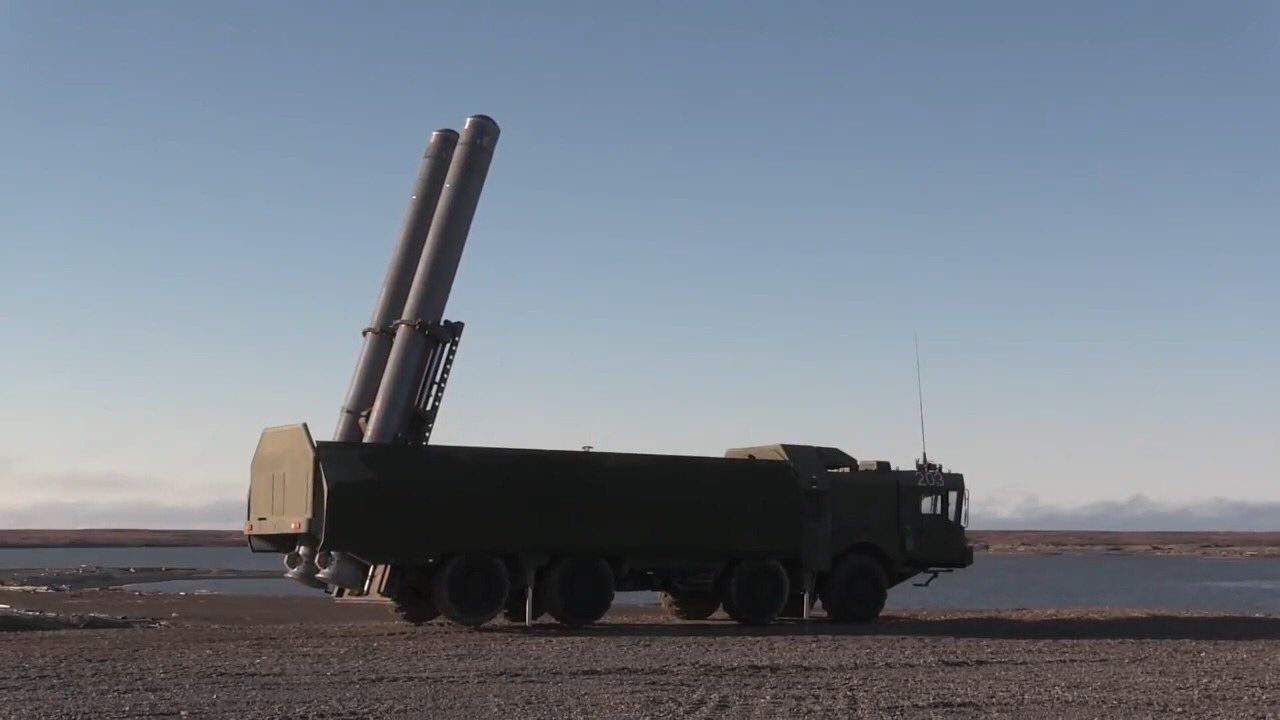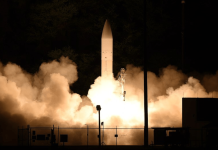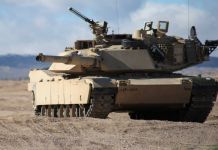Russia has rolled its Bastion coastal defence missile launchers onto the bleak shoreline of the Barents Sea, a dramatic opening move in the navy‑wide exercise codenamed “July Storm.”
Overseen by Admiral Alexander Moiseyev—
Running 23–27 July, ‘July Storm’ spans four maritime regions—the Pacific, Arctic, Baltic and Caspian Seas—making it the year’s most expansive Russian naval workout.
Moscow says the exercise involves 150 warships and auxiliaries, 120 aircraft, 10 coastal missile batteries, and around 15,000 personnel.
While the Northern Fleet’s headquarters in Severomorsk has yet to publish its own ship tally, a video released by the press office shows the frigate Admiral Golovko and the cruiser Marshal Ustinov slipping out of Kola Bay toward the Barents, followed by a pair of minesweepers departing Polyarny.
After Trump & Zelenskyy, Key “US-China-Russia” Ally In The Middle-East Set To Be Shielded By NASAMS
Beyond manoeuvring hulls, the Northern Fleet’s air‑defence units have rehearsed intercepts over the Barents Sea, demonstrating—at least for the cameras—the ability to knock down inbound threats.
The Defence Ministry says the broader aim is to test “non‑standard operational tasks,” from long‑range precision strikes and unmanned systems to new-generation weapons the Kremlin has been eager to showcase.
Admiral Moiseyev has long warned that foreign militaries are expanding their Arctic presence. “The Arctic is one of the key regions where the confrontation of the world’s leading states is unfolding,” he cautioned last December.
July Storm, with its emphasis on joint actions across several fleets, looks designed to answer that challenge—and to signal that Russia intends to hold its ground, missile batteries and all, at the top of the world.
The Barents Sea & Kola Peninsula
The Barents Sea, a key Arctic Ocean marginal sea, lies off the northern coasts of Norway and Russia, which are split between their respective territorial waters. Once known as the Northern or Murmansk Sea by Russians, it became the focus of a 2010 maritime border agreement between Moscow and Oslo.
Flanked by the Kola Peninsula to the south, Svalbard to the northwest, Franz Josef Land to the northeast, and Novaya Zemlya to the east, the Barents serves as a strategic gateway to the Arctic.
For Russia, this frigid expanse is more than geography—it’s a vital hub for naval deployments and strategic submarine (SSBN) deterrence patrols, especially from bases clustered around the Kola Peninsula.
Bastion Missile System
Russia’s coastal defenses lean heavily on two powerful systems: the K-300P Bastion-P (SSC-5 “Stooge”) and the 3K60 Bal (SSC-6 “Sennight”).
Of these, Bastion-P stands out as a formidable shield along the Russian coastline.
Armed with P-800 Oniks supersonic cruise missiles, Bastion can guard over 600 km of shoreline and strike enemy warships up to 300 km away. These missiles fly at blistering speeds of 750 meters per second, skimming just 10–15 meters above the sea in their final approach to evade radar detection.

What makes the system even more lethal is its dual-mode seeker—a mix of active radar and infrared imaging that can pick out a specific target from a fleet, even under heavy jamming.
Each mobile launcher carries two vertically launched Oniks missiles, capable of carrying warheads weighing 200–250 kg, depending on the mission type.
Bastion is more than just a defensive tool—it delivers stand-off precision strike capability that raises the stakes for any foreign navy nearing Russian waters. In today’s climate of heightened friction with NATO, its deployment in regions like the Barents Sea is a clear message: approach with caution.
Norway & U.S. Monitor Russian Moves In The Barents
As Russian warships surged into the Barents Sea for “July Storm,” NATO’s watchful eyes weren’t far behind.
On Wednesday afternoon, a Norwegian P-8 Poseidon maritime patrol aircraft flew over the western edge of the exercise zone, keeping tabs on the Northern Fleet’s maneuvers from above.
Just a day earlier, a US RC-135 Rivet Joint electronic surveillance aircraft made a high-tech sweep near Russia’s Arctic stronghold. Flying through Norwegian airspace, the spy plane traced a path close to the Kola Peninsula—home to Russia’s most sensitive naval assets—before looping back south via Finland.
The message was clear: while Russia drills in the Arctic, NATO is closely watching every move.
Bastion Moves & NATO’s Shadow
Russia’s latest Bastion coastal missile deployment isn’t just a training routine—it’s a deliberate reinforcement of its “bastion defense” strategy, aimed at locking down the Kola Peninsula and shielding key assets like ballistic missile submarines. The move is meant to deter NATO forces from pushing too close, especially in sensitive chokepoints like the Bear Gap, noted Vijainder K Thakur, a retired Indian Air Force Jaguar pilot and military analyst, in a recent post on X (formerly Twitter).
Moscow’s posture is also a direct response to what it sees as growing NATO pressure. Among the most significant developments: the U.S. reactivating its Second Fleet in 2018, and NATO’s creation of the Joint Force Command in Norfolk in 2021—both seen by Russian Navy chief Admiral Aleksandr Moiseev as ‘deliberate provocations’.
Adding to the strain, Russia found itself frozen out of the Arctic Council in March 2022 following the launch of its so-called “special military operation” in Ukraine. The suspension—enforced by the seven other Arctic states, including the U.S., Canada, and Norway—was especially symbolic, given that Russia held the rotating chair at the time.
Meanwhile, NATO’s Nordic expansion, with Finland and Sweden joining the alliance, has transformed the Baltic Sea into a near “NATO lake,” tightening the strategic noose around Russia’s northwestern flank.
Exercises like Baltic Sentry and Northern Viking 24 have only reinforced the perception in Moscow that NATO is building the muscle to contain Russia at sea. The redeployment of the Bastion missile system, previously seen in Crimea as a deterrent in the Black Sea, now sends a clear signal: Russia is fortifying its Arctic stronghold—and it’s not backing down.
Caution Amid Confrontation
“The rising tensions in the Barents Sea aren’t of Russia’s choosing—they’re a reaction,” concluded Vijainder K Thakur. “Just as NATO’s eastward march on land pushed Russia toward launching its ‘special military operation’ in Ukraine, its growing military footprint in the Arctic is now forcing Moscow to shore up its coastal defenses.”
According to Thakur, Russia’s response so far has been measured—focused on fortifying strategic points rather than provoking direct conflict.
Drawing a sharp comparison, he added: “NATO today mirrors the behavior of the Pakistan Army—keeping itself relevant through constant demonization of the adversary, flexing muscle where none is needed, and fueling tensions to justify its own existence.”
In his view, the message behind Moscow’s Arctic deployments is not about escalation—but about drawing a line in the ice.
For Moscow, the takeaway is simple: the Arctic is no longer a frozen periphery—it’s a live theater. And through the July Storm, Russia is making it clear that it intends to defend this theater—with radar-seeking missiles, air defenses, and unwavering posture.
The ice may be melting, but the lines being drawn in it are hardening fast.
- Shubhangi Palve is a defense and aerospace journalist. Before joining the EurAsian Times, she worked for ET Prime. She has over 15 years of extensive experience in the media industry, spanning print, electronic, and online domains.
- Contact the author at shubhapalve (at) gmail.com




